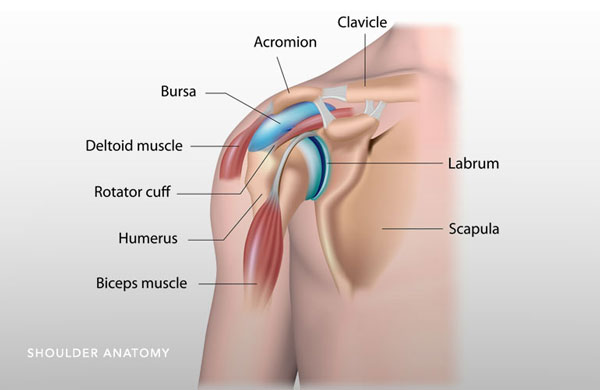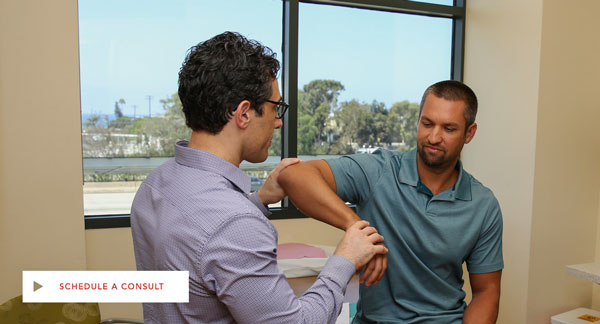
Shoulder impingement syndrome affects about 20% of all people at some time in their lives. Shoulder injuries are common among all age groups. Older adults with age-related changes in the shoulder, and athletes are most commonly affected.
Shoulder anatomy
In the shoulder, the rotator cuff is surrounded by bone. Raising the arm overhead narrows the space between the bone and the rotator cuff. Over time or with injury, the muscles, tendons and bursae can be pinched and irritated. The bursae are fluid filled sacs designed to reduce friction in the joint and allow the shoulder to move smoothly.

What is Shoulder Impingement Syndrome?
Impingement syndrome is pinching of the muscles, tendons and bursae between the upper arm bone and the shoulder blade.
Because the rotator cuff is surrounded by bone, any injury or wear and tear changes in the shoulder structures increases pressure within the joint, causing swelling and compression of the rotator cuff, and reduced blood flow.
The increased pressure and reduced blood flow initiate a cascade of events leading to inflammation of the tendons (tendinitis) and the bursae (bursitis); and weakening of the tendons causing them to fray. In the worst cases, the rotator cuff tendons and the biceps muscle tendon can rupture.
What causes shoulder impingement syndrome?
Impingement can result from a minor injury or wear and tear. Work and sports that overload the shoulder are the cause of impingement and injury. Any time the shoulder is forced to move beyond its range of motion injury can occur.
What are the symptoms?
Impingement symptoms are very similar to tear symptoms.
- Stiffness and pain with or without movement and at rest
- Pain that radiates down the arm
- Difficulty lifting the arm
- Loss of strength and motion
- Sudden pain when lifting and reaching
- Pain at night
- A feeling of instability
How is it diagnosed?
Dr. Stark will evaluate your medical history and conduct a careful physical exam with certain muscle tests to determine range of motion, strength and impairment. The symptoms of a rotator cuff tear are similar to a rotator cuff impingement, and Dr. Stark will evaluate the shoulder to rule out a tear. X-rays may be ordered to eliminate arthritis, bone spurs and calcifications, and to view the position of the bones which can imply a tear.
An MRI will diagnose the tears and determine the size and type of tear. Injections and arthroscopy may help with diagnosis. A diagnostic Injection of a local anesthetic will help the doctor distinguish between impingement and tears. If the pain is blocked, and shoulder strength remains, it is likely impingement. If strength does not return while the pain is blocked, it is likely a tear. The goal of treatment is to relieve pain and restore function.

What is the treatment?
CONSERVATIVE TREATMENT
Nonsurgical treatment will improve the symptoms for the vast majority of patients.
- Rest, icing and activity modification
- Anti-inflammatory medications
- Physical therapy
- Steroid injections when pain is not relieved with therapy, rest and medication.
When this fails to provide relief and restore function, surgery may be recommended.
DECOMPRESSION SURGERY
Surgical decompression is an operation to treat impingement by opening up the space between the shoulder blade and the rotator cuff tendons to reduce irritation and swelling of the tendons and bursa, and to remove any bone spurs.
Usually minimally invasive surgery with arthroscopy is used to view the inside of the joint and treat the bone and soft tissue. The part of the bone that is damaging the tendons will be removed, along with inflamed bursae and bone spurs. This will increase the space between the bone and cuff tissues. If there are rotator cuff tears, they may also be repaired during decompression surgery. However, if large tears of the rotator cuff are identified, open surgery may be necessary.
Decompression surgery, whether open or minimally invasive, is successful in reducing shoulder impingement pain in 77-90% of patients.
The length of recovery varies but improvements will be obvious within 3-6 months. Physical therapy to recover strength and function is important for full recovery. Dr. Stark has office in Carlsbad.
